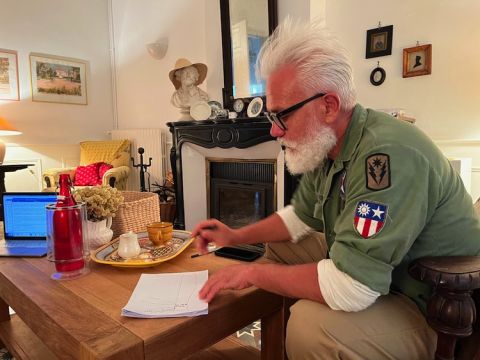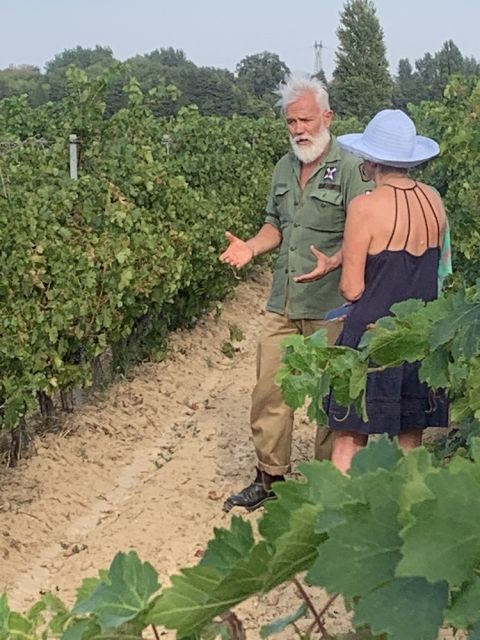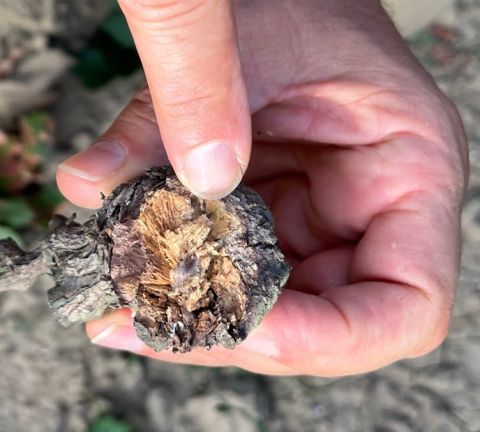Marco Simonit – pruning superstar

King Vine Pruner visited Jancis in the Languedoc last month. A much shorter version of this account is published by the Financial Times.
Marco Simonit is a details person. If you serve him one of the many cups of coffee he drinks each day, he’d like a little jug of milk, cold milk, next to it. His recent overnight stay with us in the Languedoc was preceded by a list of seven dietary prohibitions. When I showed him his bathroom he asked whether he was sharing it with anyone. It was 40 °C outside during the day that I interviewed him so I shut the shutters and turned on a fan. After a few minutes he asked me to angle the fan away from him, even though he was wearing a US army jacket and a T-shirt. He fretted over whether Ch Pichon Lalande could be called Pichon Longueville. He pronounced the Gonet 2012 champagne I served him before (a carefully chosen) dinner ‘good, but too warm’.
Caring about viticultural detail with the same sort of precision has won him more than 150 clients around the world, including many of the most revered wine producers of all. His speciality is vine pruning, a slightly esoteric subject but a task that every grower has to perform on every vine every winter.
After all, the grapevine is naturally a creeper. It needs persuasion to yield buds that will become bunches of grapes in the right quantity and the right place. Until Simonit really got going with his pruning consultancy about 20 years ago, most vine growers imposed a set pattern of pruning, usually uniform throughout each wine region, on the plant. Simonit’s technique, sometimes called ‘gentle pruning’, is to do what each vine calls for in order to enjoy a long and healthy life. Although he admits it takes at least five years to show results, what he’s aiming at is a vineyard full of well-balanced vines that ripen evenly and do their best to resist pests, diseases and the effects of climate change. This holistic approach has never been more appealing now that so many vines are suffering from often fatal vine trunk diseases. ‘It’s like a pandemic situation around the world’, according to Simonit. The seriousness of the situation is confirmed by an OIV report, updated last month and downloadable below. 80% of vines in some southern Italian vineyards are affected; 12% of French vineyards are reckoned to be economically non-viable because of vine trunk disease.
Although Bordeaux has been suffering particularly because its Cabernet Sauvignon and Sauvignon Blanc vine varieties are especially susceptible to esca, one of the most common vine blights, Simonit is also starting to see problems in Burgundy where vines can just keel over and die because of a bubble in their vascular system.
Esca was already becoming a serious concern in Collio, the wine region in the far north-east of Italy, when Simonit was growing up there on the family farm. Its livestock were his first love but he also loves drawing. (He covered 12 A4 sheets with diagrams of vines during our interview.) Drawing the trees and vines surrounding his family’s farm, he became curious about the wounds he saw on the vines. These were standard pruning wounds, the scars left after routine pruning. ‘What happened behind these wounds?’ he asked rhetorically, recalling his youthful curiosity. When he cut through these wounds he discovered dead wood, the result of the fungi that spread trunk diseases. ‘No one in the wine schools spoke about this. The internet didn’t exist. There were no books that explained it.’ (This was at a time when all the wine world’s focus was on what happened in the cellar, not vineyard, with winemakers and winemaking consultants the superstars.)
From the late 1980s Simonit, now 56, observed vines particularly carefully, working for 10 years for the Collio growers’ association. ‘I said to myself, one day maybe something interesting could happen.’ He understood that the best wines come from old vines and went to inspect particularly ancient vines in the south and islands of Italy. He drove across southern France and northern Spain too, trying to understand exactly why and how these vines survived.
Having come up with the idea of pruning each vine as an individual, giving it the ‘dynamic architecture’ it needs, with the smallest of cuts that respect the flow of sap and age of the wood, he persuaded the celebrated Collio wine producer Mario Schioppetto to let him prune a few rows of his vines to try out his theories. When Simonit saw how well the vines responded, word spread and by 1999 he quit his job to advise local Friuli growers, starting to train others and build a team. He formed the business Simonit & Sirch in 2003, Pierpaolo Sirch being a schoolfriend of Simonit’s who looks after all the admin, for they now have companies in France, the US, South Africa and are thinking about branches in Spain and Germany too.
Confident in his methods, he contacted a few of Italy’s professors of viticulture. Only the influential Attilio Scienza replied but by 2003 he had agreed to come and see Simonit’s work. Simonit remembers his reaction well. ‘He said, “Oh wow! This is incredible – very interesting. I need to tell other Italian producers about this.” He called all the top producers. I thought hurray, someone believes in this and me.’
The turning point for Simonit was a visit from world-famous Italian wine producer Angelo Gaja, who turned up with both his Piemontese and Tuscan vineyard teams and within two weeks signed a contract. Top Italian sparkling-wine producers Bellavista and Ferrari signed up at more or less the same time and soon Simonit was getting calls from all over Italy.
It was the late Professor Denis Dubourdieu of Bordeaux who opened the door to his long and illustrious list of French clients, including Ch Latour, Ch d’Yquem and Domaine de la Romanée-Conti. Dubourdieu was appalled by the extent of trunk disease in Bordeaux and was determined to find a practical solution. Having met Simonit at a viticultural conference in Bolzano in 2010, he invited him to present his methods to the great and the good of Bordeaux wine producers in 2011. It was Dubourdieu who gave Simonit René Lafon’s 1921 book outlining the pruning methods of a late-19th-century vine-grower in Charentes called Poussard, which also depended on respecting the flow of the sap. ‘Until I was given this book’, Simonit told me, ‘I’d never read anything about pruning in books.’
‘Denis Dubourdieu changed my life’, says Simonit who now runs a staff of 27 pruning consultants around the world. But of course the most famous clients want the most famous consultant, which puts a natural brake on accepting new business. ‘Though we can always charge more’, smiles Simonit, whose annual turnover is now nearly €4 million. When he visited he had just come back from advising the team at Champagne Bollinger’s new outpost in Oregon, Ponzi Vineyards.
But another Champagne house, Louis Roederer, has been one of his most faithful clients. Back in 2012, when he was starting to amass clients in Bordeaux, he was called to a 7 am meeting in a vineyard in Aÿ with the Roederer group’s technical director, the astute Jean-Baptiste Lécaillon. There was another, quiet man with him whom Simonit assumed was one of his assistants. It was only about 12 hours later when Lécaillon asked Simonit if he would advise the entire Roederer group, including Ch Pichon Lalande in Bordeaux and their properties in California, that he realised this was Frédéric Rouzaud, the group’s CEO.
With traditional methods of pruning, quite apart from their susceptibility to trunk disease, yields tend to decline with vine age so that vineyards have systematically been pulled out and replanted after about 20 years, just as the quality of the grapes gets into its stride. But according to Simonit, a thoughtfully pruned vine can continue to produce great wine for many more decades.
‘When you go into a vineyard, you can read vines like a book. You can’t cover anything up. Lots of people ask what is the best vine-training system. It doesn’t exist. You have to understand where you are, what conditions the vine grows in.’
Since our village in the Languedoc is surrounded by vines, I thought it was time, despite the heat, to go and look at them. Unfortunately, our nearest vineyard turned out to be a less-than-edifying read. As soon as we approached it he shook his head. ‘Cabernet Sauvignon. This guy is super-sensitive to esca.’ Sure enough, large patches of brown, dessicated leaves punctuated the green in every row. He homed in on the vine trunks, pointing out little stubs that are the pruning wounds and, rather terrifyingly, started to snap off huge chunks of dead wood, pulling them apart to show the fungus inside. The vine trunks trembled as he did so, looking as though they might keel over any minute. ‘Dead, dead – do you see?’ he pointed to one plant. I looked nervously at the houses overlooking the vineyard, hoping that the vineyard’s owner didn’t live in one of them.
Back inside, I wondered how he came up with a price for his services. He is big on their ‘tailor-made contracts’ and their ‘standard operating procedure’ document for each client, which guards against personnel changes in either the client’s or his own team. Most contracts are for a minimum of five years. ‘The good guys understand that it’s not like a sudden turnaround.’ He swivelled his phone through 90 degrees. ‘But some clients want just one year’s advice, especially in Italy. You know … Italians’ “creativity”.’
I asked more than a dozen of Simonit’s clients how they felt about his impact on their vineyards and only one voiced the slightest bit of criticism: that their esca had not been cured. Everyone commented on the improvement in worker morale. I wondered whether his theories could be applied to plants other than the vine. Apparently he has already been asked about kiwi fruits, olives and apples. ‘For sure it would be possible’, he says, ‘but I’m focused on vines.’
Before any inspection there’s an extremely detailed questionnaire covering, inter alia, how many people work in the winery and whether they use vineyard contractors. This is particularly important in California, where outside vineyard-management companies are much more common than, for example, in Burgundy, where the vineyards are generally worked by the famous winemakers themselves. Apparently with some California winery owners, reluctant to have outside contractors trained who might use their newfound knowledge elsewhere, non-disclosure agreements may even be involved.
But Simonit is explicitly pro sharing. ‘I’m never scared of sharing knowledge because by sharing you learn. And anyway ours is the only team in the world spread in the most important wine regions and we get lots of information day by day. During COVID I wanted to share my experience. So I built the first digital platform teaching vine pruning.’ The Vine Master Pruners Academy, in Italian, English and Spanish, already has 15,000 subscribers in 14 countries.
As well as their recently opened pruning academy-cum-hotel in Collio, in 2016 they established a Master’s degree course in pruning and shoot-thinning with the University of Bordeaux and, in collaboration with various other research institutes and universities they have on-site, in-person pruning schools in Italy, Napa Valley, Lake County in Oregon, Plumpton in the UK, Geisenheim in Germany, Adelaide Hills, Hungary and Tarragona.
But the thing of which I suspect Simonit is most proud is the social effect of his training – especially in California and South Africa, where vineyard workers have historically been undervalued and undertrained. By becoming an international superstar of wine – as consultant oenologist Michel Rolland of Bordeaux has been since the 1980s – Simonit has elevated vineyard work and with it vineyard workers.
‘When we started to work with wineries in California, we needed to teach the teams in the fields. No one had taught the Mexican workers before. But now they feel as important as people working in the cellar. It’s having a real social impact, just as in South Africa where we have five people at the moment because it’s pruning season there. The same in Australia [where Simonit has worked with Prue Henschke on her famously ancient vines, and with Penfolds on their 140-year-old Block 42 Cabernet Sauvignon] with all the Vietnamese, Cambodian and Laotian vineyard workers there. They say, “wow, someone’s teaching us now”.’
This is something much bigger than a detail.
Some relatively affordable recommended wines from Simonit's clients
Sparkling
Louis Roederer, Collection 243 Brut NV Champagne 12.5%
£43.50 Divine Fine Wines
White
Bründlmayer, Terrassen Grüner Veltliner 2021 Kamptal 12%
£19.40 Noble Grape
Inama, Vigneti Foscarino 2020 Soave Classico 12.5%
£24.95 Connolly’s Wine Merchants
Rebholz, Vom Muschelkalk Riesling trocken 2020 Pfalz 12.5%
£28.20 Justerini & Brooks
Red
Ch Reynon 2019 Cadillac Côtes de Bordeaux 14.5%
$18.59 Wine Anthology, NJ
Spier, Seaward Shiraz 2021 Coastal Region 14.2%
$19.99 Total Wine & More, CA, FL, TX
Castello ColleMassari Riserva 2016 Montecucco 14.5%
£18.20 Falcon Vintners
See scores, tasting notes and suggested drink dates in our 250,000-strong database of tasting notes. International stockists on Wine-Searcher.com.
Become a member to view this article and thousands more!
- 15,408 featured articles
- 274,574 wine reviews
- Maps from The World Atlas of Wine, 8th edition (RRP £50)
- The Oxford Companion to Wine, 5th edition (RRP £50)
- Members’ forum
- 15,408 featured articles
- 274,574 wine reviews
- Maps from The World Atlas of Wine, 8th edition (RRP £50)
- The Oxford Companion to Wine, 5th edition (RRP £50)
- Members’ forum
- Commercial use of our Tasting Notes



